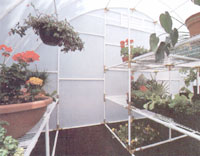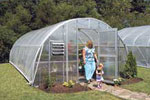|
A History of Greenhouses
A greenhouse (also called a
glasshouse, or, if with sufficient heating, a hothouse) is a
structure with walls and roof made chiefly of transparent material, such
as glass, in which plants requiring regulated climatic conditions are
grown. These structures range in size from small sheds to
industrial-sized buildings. A miniature greenhouse is known as a cold
frame. The interior of a greenhouse exposed to sunlight becomes
significantly warmer than the external ambient temperature, protecting
its contents in cold weather.
Many commercial glass greenhouses or hothouses
are high tech production facilities for vegetables or flowers. The glass
greenhouses are filled with equipment including screening installations,
heating, cooling, lighting, and may be controlled by a computer to
optimize conditions for plant growth. Different techniques are then used
to evaluate optimality-degrees and comfort ratio of greenhouse
micro-climate (i.e., air temperature, relative humidity and vapor
pressure deficit) in order to reduce production risk prior to
cultivation of a specific crop.
The idea of growing plants in environmentally
controlled areas has existed since Roman times. The Roman emperor
Tiberius ate a cucumber-like vegetable daily. The Roman gardeners used
artificial methods (similar to the greenhouse system) of growing to have
it available for his table every day of the year. Cucumbers were planted
in wheeled carts which were put in the sun daily, then taken inside to
keep them warm at night. The cucumbers were stored under frames or in
cucumber houses glazed with either oiled cloth known as specularia or
with sheets of selenite (a.k.a. lapis specularis), according to the
description by Pliny the Elder.
The first description of a heated
greenhouse is from the Sanga Yorok, a treatise on husbandry compiled by
a royal physician of the Joseon dynasty of Korea during the 1450s, in
its chapter on cultivating vegetables during winter. The treatise
contains detailed instructions on constructing a greenhouse that is
capable of cultivating vegetables, forcing flowers, and ripening fruit
within an artificially heated environment, by utilizing ondol, the
traditional Korean underfloor heating system, to maintain heat and
humidity; cob walls to insulate heat; and semi-transparent oiled hanji
windows to permit light penetration for plant growth and provide
protection from the outside environment. The Annals of the Joseon
Dynasty confirm that greenhouse-like structures incorporating ondol were
constructed to provide heat for mandarin orange trees during the winter
of 1438.
The concept of greenhouses also appeared in the
Netherlands and then England in the 17th century, along with the plants.
Some of these early attempts required enormous amounts of work to close
up at night or to winterize. There were serious problems with providing
adequate and balanced heat in these early greenhouses. Today, the
Netherlands has many of the largest greenhouses in the world, some of
them so vast that they are able to produce millions of vegetables every
year.
The French botanist Charles Lucien Bonaparte is often
credited with building the first practical modern greenhouse in Leiden,
Holland, during the 1800s to grow medicinal tropical plants. Originally
only on the estates of the rich, the growth of the science of botany
caused greenhouses to spread to the universities. The French called
their first greenhouses orangeries, since they were used to protect
orange trees from freezing. As pineapples became popular, pineries, or
pineapple pits, were built.
Experimentation with the design of
greenhouses continued during the 17th century in Europe, as technology
produced better glass and construction techniques improved. The
greenhouse at the Palace of Versailles was an example of their size and
elaborateness; it was more than 150 metres (490 ft) long, 13 metres (43
ft) wide, and 14 metres (46 ft) high.
The golden era of the
greenhouse was in England during the Victorian era, where the largest
glasshouses yet conceived were constructed, as the wealthy upper class
and aspiring botanists competed to build the most elaborate buildings. A
good example of this trend is the pioneering Kew Gardens. Joseph Paxton,
who had experimented with glass and iron in the creation of large
greenhouses as the head gardener at Chatsworth, in Derbyshire, working
for the Duke of Devonshire, designed and built The Crystal Palace in
London, (although the latter was constructed for both horticultural and
non-horticultural exhibition).
Other large greenhouses built in
the 19th century included the New York Crystal Palace, Munich’s
Glaspalast and the Royal Greenhouses of Laeken (1874–1895) for King
Leopold II of Belgium.
|
![]()
![]()
![]()
![]()
![]()





